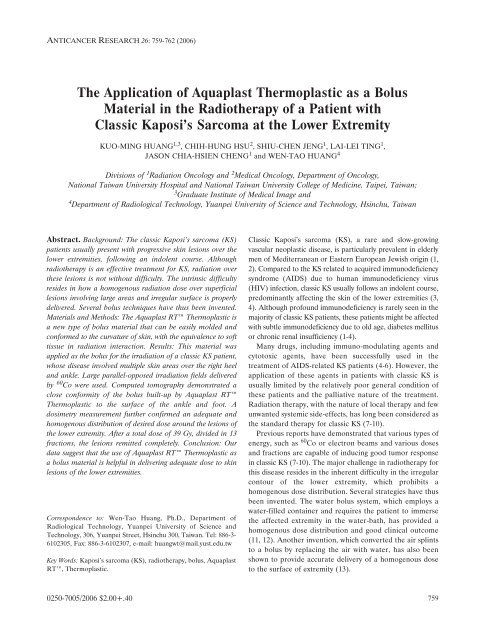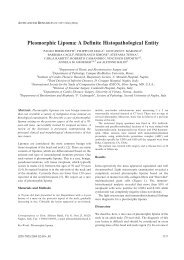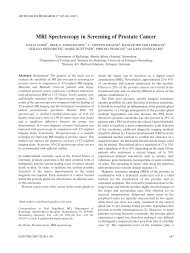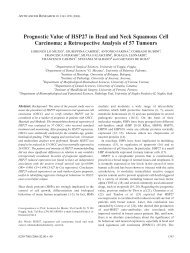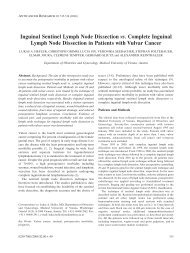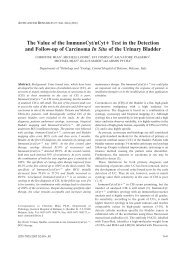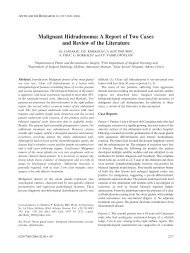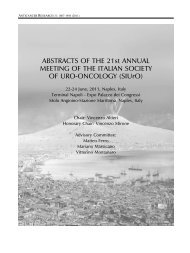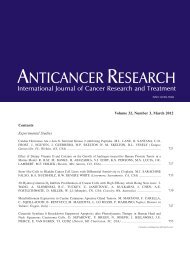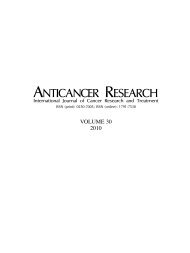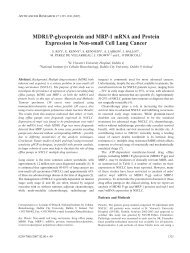The Application of Aquaplast Thermoplastic as a Bolus Material in ...
The Application of Aquaplast Thermoplastic as a Bolus Material in ...
The Application of Aquaplast Thermoplastic as a Bolus Material in ...
Create successful ePaper yourself
Turn your PDF publications into a flip-book with our unique Google optimized e-Paper software.
ANTICANCER RESEARCH 26: 759-762 (2006)<br />
<strong>The</strong> <strong>Application</strong> <strong>of</strong> <strong>Aquapl<strong>as</strong>t</strong> <strong>The</strong>rmopl<strong>as</strong>tic <strong>as</strong> a <strong>Bolus</strong><br />
<strong>Material</strong> <strong>in</strong> the Radiotherapy <strong>of</strong> a Patient with<br />
Cl<strong>as</strong>sic Kaposi’s Sarcoma at the Lower Extremity<br />
KUO-MING HUANG 1,3 , CHIH-HUNG HSU 2 , SHIU-CHEN JENG 1 , LAI-LEI TING 1 ,<br />
JASON CHIA-HSIEN CHENG 1 and WEN-TAO HUANG 4<br />
Divisions <strong>of</strong> 1 Radiation Oncology and 2 Medical Oncology, Department <strong>of</strong> Oncology,<br />
National Taiwan University Hospital and National Taiwan University College <strong>of</strong> Medic<strong>in</strong>e, Taipei, Taiwan;<br />
3 Graduate Institute <strong>of</strong> Medical Image and<br />
4 Department <strong>of</strong> Radiological Technology, Yuanpei University <strong>of</strong> Science and Technology, Hs<strong>in</strong>chu, Taiwan<br />
Abstract. Background: <strong>The</strong> cl<strong>as</strong>sic Kaposi’s sarcoma (KS)<br />
patients usually present with progressive sk<strong>in</strong> lesions over the<br />
lower extremities, follow<strong>in</strong>g an <strong>in</strong>dolent course. Although<br />
radiotherapy is an effective treatment for KS, radiation over<br />
these lesions is not without difficulty. <strong>The</strong> <strong>in</strong>tr<strong>in</strong>sic difficulty<br />
resides <strong>in</strong> how a homogenous radiation dose over superficial<br />
lesions <strong>in</strong>volv<strong>in</strong>g large are<strong>as</strong> and irregular surface is properly<br />
delivered. Several bolus techniques have thus been <strong>in</strong>vented.<br />
<strong>Material</strong>s and Methods: <strong>The</strong> <strong>Aquapl<strong>as</strong>t</strong> RTì <strong>The</strong>rmopl<strong>as</strong>tic is<br />
a new type <strong>of</strong> bolus material that can be e<strong>as</strong>ily molded and<br />
conformed to the curvature <strong>of</strong> sk<strong>in</strong>, with the equivalence to s<strong>of</strong>t<br />
tissue <strong>in</strong> radiation <strong>in</strong>teraction. Results: This material w<strong>as</strong><br />
applied <strong>as</strong> the bolus for the irradiation <strong>of</strong> a cl<strong>as</strong>sic KS patient,<br />
whose dise<strong>as</strong>e <strong>in</strong>volved multiple sk<strong>in</strong> are<strong>as</strong> over the right heel<br />
and ankle. Large parallel-opposed irradiation fields delivered<br />
by 60 Co were used. Computed tomography demonstrated a<br />
close conformity <strong>of</strong> the bolus built-up by <strong>Aquapl<strong>as</strong>t</strong> RTì<br />
<strong>The</strong>rmopl<strong>as</strong>tic to the surface <strong>of</strong> the ankle and foot. A<br />
dosimetry me<strong>as</strong>urement further confirmed an adequate and<br />
homogenous distribution <strong>of</strong> desired dose around the lesions <strong>of</strong><br />
the lower extremity. After a total dose <strong>of</strong> 39 Gy, divided <strong>in</strong> 13<br />
fractions, the lesions remitted completely. Conclusion: Our<br />
data suggest that the use <strong>of</strong> <strong>Aquapl<strong>as</strong>t</strong> RTì <strong>The</strong>rmopl<strong>as</strong>tic <strong>as</strong><br />
a bolus material is helpful <strong>in</strong> deliver<strong>in</strong>g adequate dose to sk<strong>in</strong><br />
lesions <strong>of</strong> the lower extremities.<br />
Correspondence to: Wen-Tao Huang, Ph.D., Department <strong>of</strong><br />
Radiological Technology, Yuanpei University <strong>of</strong> Science and<br />
Technology, 306, Yuanpei Street, Hs<strong>in</strong>chu 300, Taiwan. Tel: 886-3-<br />
6102305, Fax: 886-3-6102307, e-mail: huangwt@mail.yust.edu.tw<br />
Key Words: Kaposi’s sarcoma (KS), radiotherapy, bolus, <strong>Aquapl<strong>as</strong>t</strong><br />
RTì, <strong>The</strong>rmopl<strong>as</strong>tic.<br />
0250-7005/2006 $2.00+.40<br />
Cl<strong>as</strong>sic Kaposi’s sarcoma (KS), a rare and slow-grow<strong>in</strong>g<br />
v<strong>as</strong>cular neopl<strong>as</strong>tic dise<strong>as</strong>e, is particularly prevalent <strong>in</strong> elderly<br />
men <strong>of</strong> Mediterranean or E<strong>as</strong>tern European Jewish orig<strong>in</strong> (1,<br />
2). Compared to the KS related to acquired immunodeficiency<br />
syndrome (AIDS) due to human immunodeficiency virus<br />
(HIV) <strong>in</strong>fection, cl<strong>as</strong>sic KS usually follows an <strong>in</strong>dolent course,<br />
predom<strong>in</strong>antly affect<strong>in</strong>g the sk<strong>in</strong> <strong>of</strong> the lower extremities (3,<br />
4). Although pr<strong>of</strong>ound immunodeficiency is rarely seen <strong>in</strong> the<br />
majority <strong>of</strong> cl<strong>as</strong>sic KS patients, these patients might be affected<br />
with subtle immunodeficiency due to old age, diabetes mellitus<br />
or chronic renal <strong>in</strong>sufficiency (1-4).<br />
Many drugs, <strong>in</strong>clud<strong>in</strong>g immuno-modulat<strong>in</strong>g agents and<br />
cytotoxic agents, have been successfully used <strong>in</strong> the<br />
treatment <strong>of</strong> AIDS-related KS patients (4-6). However, the<br />
application <strong>of</strong> these agents <strong>in</strong> patients with cl<strong>as</strong>sic KS is<br />
usually limited by the relatively poor general condition <strong>of</strong><br />
these patients and the palliative nature <strong>of</strong> the treatment.<br />
Radiation therapy, with the nature <strong>of</strong> local therapy and few<br />
unwanted systemic side-effects, h<strong>as</strong> long been considered <strong>as</strong><br />
the standard therapy for cl<strong>as</strong>sic KS (7-10).<br />
Previous reports have demonstrated that various types <strong>of</strong><br />
energy, such <strong>as</strong> 60 Co or electron beams and various doses<br />
and fractions are capable <strong>of</strong> <strong>in</strong>duc<strong>in</strong>g good tumor response<br />
<strong>in</strong> cl<strong>as</strong>sic KS (7-10). <strong>The</strong> major challenge <strong>in</strong> radiotherapy for<br />
this dise<strong>as</strong>e resides <strong>in</strong> the <strong>in</strong>herent difficulty <strong>in</strong> the irregular<br />
contour <strong>of</strong> the lower extremity, which prohibits a<br />
homogenous dose distribution. Several strategies have thus<br />
been <strong>in</strong>vented. <strong>The</strong> water bolus system, which employs a<br />
water-filled conta<strong>in</strong>er and requires the patient to immerse<br />
the affected extremity <strong>in</strong> the water-bath, h<strong>as</strong> provided a<br />
homogenous dose distribution and good cl<strong>in</strong>ical outcome<br />
(11, 12). Another <strong>in</strong>vention, which converted the air spl<strong>in</strong>ts<br />
to a bolus by replac<strong>in</strong>g the air with water, h<strong>as</strong> also been<br />
shown to provide accurate delivery <strong>of</strong> a homogenous dose<br />
to the surface <strong>of</strong> extremity (13).<br />
759
Here<strong>in</strong>, we report our experience with a new material<br />
that is highly shapeable and h<strong>as</strong> the equivalence <strong>of</strong> s<strong>of</strong>t<br />
tissue <strong>in</strong> radiation <strong>in</strong>teraction, the <strong>Aquapl<strong>as</strong>t</strong> RTì<br />
<strong>The</strong>rmopl<strong>as</strong>tic, <strong>in</strong> the treatment <strong>of</strong> a patient with cl<strong>as</strong>sic KS<br />
at the lower extremity. Our experience suggested that this<br />
is an e<strong>as</strong>ily applied and reliable way <strong>of</strong> deliver<strong>in</strong>g adequate<br />
sk<strong>in</strong> dose to lower extremities.<br />
<strong>Material</strong>s and Methods<br />
<strong>Material</strong>s. <strong>Aquapl<strong>as</strong>t</strong> RTì <strong>The</strong>rmopl<strong>as</strong>tic is 2-oxepanone, polymer<br />
with 1,4-butanediol (synonyms: Caprolactone, 1,4-butanediol<br />
polymer epsilon-Caprolactone, or 1,4-butanediol polyester)<br />
(WFR/<strong>Aquapl<strong>as</strong>t</strong> Corp., Wyck<strong>of</strong>f, NJ, USA). This material h<strong>as</strong> been<br />
shown <strong>as</strong> an effective bolus material; with thicknesses <strong>of</strong> 0.5 cm or<br />
1 cm, <strong>Aquapl<strong>as</strong>t</strong> RTì <strong>The</strong>rmopl<strong>as</strong>tic shows less than 2% <strong>of</strong><br />
difference <strong>in</strong> comparison with polystyrene or superflab boluses, two<br />
commonly used bolus materials, when irradiated with 6 to 12 MV<br />
photon us<strong>in</strong>g a 10 cm x 10 cm field size (14).<br />
<strong>Bolus</strong> technique. <strong>The</strong> patient w<strong>as</strong> <strong>as</strong>ked to position himself <strong>as</strong><br />
comfortably <strong>as</strong> possible while the lesions were amenable to<br />
irradiation. With the support <strong>of</strong> B<strong>as</strong>e Plate (MED-TEC, Orange,<br />
IA, USA), several 0.2-cm thick <strong>Aquapl<strong>as</strong>t</strong> RTì <strong>The</strong>rmopl<strong>as</strong>tic<br />
sheets, after heat<strong>in</strong>g at around 60 ~ 70ÆC, were gathered to fit the<br />
contour <strong>of</strong> the lower extremity <strong>of</strong> the patient. After cool<strong>in</strong>g at<br />
room temperature, a more than 0.5-cm thick <strong>Aquapl<strong>as</strong>t</strong> RTì<br />
<strong>The</strong>rmopl<strong>as</strong>tic sheet w<strong>as</strong> solidified like a "shell" with a nearly<br />
perfect fit to the surface <strong>of</strong> the lesion <strong>in</strong> order to <strong>of</strong>fer adequate<br />
electron scatter<strong>in</strong>g. <strong>The</strong> support <strong>of</strong> the b<strong>as</strong>e plate and the set-up<br />
shell made <strong>of</strong> <strong>Aquapl<strong>as</strong>t</strong> RTì <strong>The</strong>rmopl<strong>as</strong>tic helped to position<br />
the leg/ foot reliably for daily radiation delivery.<br />
Results<br />
C<strong>as</strong>e presentation. In Feb 2005, a 73-year-old man w<strong>as</strong><br />
referred to the Division <strong>of</strong> Radiation Oncology, Department<br />
<strong>of</strong> Oncology, National Taiwan University Hospital, Taipei,<br />
Taiwan, for multiple KS lesions over the right foot and<br />
ankle. <strong>The</strong> patient had been tak<strong>in</strong>g medications for several<br />
systemic dise<strong>as</strong>es, <strong>in</strong>clud<strong>in</strong>g hypertension, diabetes mellitus,<br />
coronary arterial dise<strong>as</strong>e, hyperlipidemia, hyperuricemia<br />
and benign prostate hypertrophy, for more than 10 years.<br />
He had received an angiopl<strong>as</strong>ty for coronary arterial dise<strong>as</strong>e<br />
complicated with an episode <strong>of</strong> acute myocardial <strong>in</strong>farction<br />
7 years before and had another operation for gall stone 6<br />
years before.<br />
A gradual appearance <strong>of</strong> purplish-pigmented sk<strong>in</strong><br />
lesions over the right lower extremity had been noted for<br />
half a year. At the Dermatology Cl<strong>in</strong>ic, he w<strong>as</strong> found to<br />
have more than 40 discrete lesions with sizes vary<strong>in</strong>g from<br />
p<strong>in</strong>head to rice-gra<strong>in</strong> over the sk<strong>in</strong> around right heel and<br />
right ankle. Mild tenderness w<strong>as</strong> perceived. <strong>The</strong>re w<strong>as</strong> no<br />
obvious lymphedema. An excision biopsy <strong>of</strong> the sk<strong>in</strong><br />
lesion confirmed KS. <strong>The</strong> serology <strong>of</strong> anti-HIV w<strong>as</strong><br />
negative.<br />
760<br />
ANTICANCER RESEARCH 26: 759-762 (2006)<br />
Radiation <strong>of</strong> sk<strong>in</strong> lesions. <strong>The</strong> radiation field w<strong>as</strong> planned to<br />
cover the whole right foot and the very lower part <strong>of</strong> the<br />
right leg, <strong>in</strong>clud<strong>in</strong>g the entire ankle. A 0.5-cm thick sheet <strong>of</strong><br />
<strong>Aquapl<strong>as</strong>t</strong> RTì <strong>The</strong>rmopl<strong>as</strong>tic w<strong>as</strong> molded to enclose the<br />
whole right foot and ankle. As shown <strong>in</strong> Figure 1, the foot<br />
w<strong>as</strong> "shelled" with a sheet <strong>of</strong> <strong>Aquapl<strong>as</strong>t</strong> RTì <strong>The</strong>rmopl<strong>as</strong>tic.<br />
In order to have a quick, accurate and repeatable position<strong>in</strong>g<br />
<strong>of</strong> the lesion foot <strong>as</strong> well <strong>as</strong> a better immobilization dur<strong>in</strong>g<br />
the radiation therapy, a MED-TEC b<strong>as</strong>e plate (MED-TEC)<br />
w<strong>as</strong> also employed <strong>in</strong> conjunction with the "shell" or the<br />
bolus made <strong>of</strong> <strong>Aquapl<strong>as</strong>t</strong> RTì <strong>The</strong>rmopl<strong>as</strong>tic (Figure 1). A<br />
follow-up computed tomography (CT) demonstrated a very<br />
close conformity <strong>of</strong> the bolus made <strong>of</strong> <strong>Aquapl<strong>as</strong>t</strong> RTì<br />
<strong>The</strong>rmopl<strong>as</strong>tic and the contour <strong>of</strong> the foot (Figure 2).<br />
<strong>The</strong> radiation w<strong>as</strong> given with 60 Co <strong>as</strong> source <strong>of</strong> energy<br />
delivered by <strong>The</strong>ratron1000 (<strong>The</strong>ratronic, Ottawa, Canada),<br />
with 2 oppos<strong>in</strong>g fields from lateral tangent and medial<br />
tangent approaches. <strong>The</strong> field size w<strong>as</strong> 11 cm x 14 cm. <strong>The</strong><br />
treatment consisted <strong>of</strong> 13 fractions <strong>of</strong> 3 Gy per day for a<br />
total dose <strong>of</strong> 39 Gy.<br />
Treatment outcomes. A dosimetric evaluation w<strong>as</strong><br />
performed. As revealed <strong>in</strong> Figure 2, the dose at the sk<strong>in</strong><br />
surface around the ankle and heel w<strong>as</strong> equally distributed,<br />
with 100% or more <strong>of</strong> the planned dose.<br />
<strong>The</strong> patient w<strong>as</strong> treated throughout the planned course<br />
uneventfully. Except a very mild erythema <strong>of</strong> the irradiated<br />
sk<strong>in</strong>, there w<strong>as</strong> no obvious toxicity. Three months after<br />
completion <strong>of</strong> radiation the KS lesions remitted completely.<br />
Discussion<br />
A water-b<strong>as</strong>ed bolus technique us<strong>in</strong>g a water bath tank h<strong>as</strong><br />
been one <strong>of</strong> the most commonly used methods to deliver<br />
radiation for superficial sk<strong>in</strong> lesions <strong>of</strong> the extremities (11,<br />
12). However, <strong>in</strong> our experience, the water bath technique is<br />
cumbersome and sometimes impractical for patients with<br />
poor performance status to immerse the affected limb <strong>in</strong> the<br />
tank. Dur<strong>in</strong>g the treatment, it is also <strong>of</strong>ten messy due to<br />
water spillage. Furthermore, when lesions are complicated<br />
with wounds or ulcerations, the potential <strong>in</strong>fection <strong>of</strong> the<br />
wound itself and the contam<strong>in</strong>ation from the water <strong>in</strong> c<strong>as</strong>e<br />
<strong>of</strong> the spillage can be problematic. Our technique, which<br />
avoids the above-mentioned drawbacks, is relatively neat. In<br />
addition, the e<strong>as</strong>y and reliably high reposition made this<br />
approach "user-friendly" for patients under treatment.<br />
Similar approaches like this have been commonly<br />
applied for patients with head and neck cancers receiv<strong>in</strong>g<br />
radiation therapy. <strong>The</strong> application <strong>of</strong> pl<strong>as</strong>tic shell <strong>in</strong><br />
treat<strong>in</strong>g patients with head and neck cancers is ma<strong>in</strong>ly<br />
b<strong>as</strong>ed on a better and reliable reposition<strong>in</strong>g for<br />
radiotherapy. <strong>The</strong> <strong>Aquapl<strong>as</strong>t</strong> RTì <strong>The</strong>rmopl<strong>as</strong>tic used <strong>in</strong><br />
this report had dual benefits <strong>in</strong> treat<strong>in</strong>g sk<strong>in</strong> lesions over
Huang et al: <strong>Aquapl<strong>as</strong>t</strong> <strong>The</strong>rmopl<strong>as</strong>tic <strong>in</strong> Radiation <strong>of</strong> Kaposi’s Sarcoma<br />
Figure 1. Cl<strong>in</strong>ical set-up for the treatment <strong>of</strong> KS lesions <strong>of</strong> the lower extremity us<strong>in</strong>g <strong>Aquapl<strong>as</strong>t</strong> RTì <strong>The</strong>rmopl<strong>as</strong>tic with the support <strong>of</strong> a B<strong>as</strong>e Plate.<br />
the lower extremities. First, it served <strong>as</strong> a typical "shell" for<br />
reposition<strong>in</strong>g <strong>of</strong> the irradiated region. Second, it acted <strong>as</strong> a<br />
bolus material for sk<strong>in</strong> lesions because <strong>of</strong> a perfect<br />
equivalence to the s<strong>of</strong>t-tissue <strong>in</strong>teract<strong>in</strong>g with radiation.<br />
Figure 2. CT imag<strong>in</strong>g <strong>of</strong> the foot covered<br />
with a bolus <strong>of</strong> <strong>Aquapl<strong>as</strong>t</strong> RTì<br />
<strong>The</strong>rmopl<strong>as</strong>tic with dose calculation.<br />
<strong>The</strong> good conformity and good bolus characteristic <strong>of</strong> this<br />
material provided a homogenous radiation distribution at<br />
the surface <strong>of</strong> sk<strong>in</strong> <strong>in</strong> a relatively large area with uneven<br />
contour, <strong>as</strong> <strong>in</strong> our c<strong>as</strong>e.<br />
761
F<strong>in</strong>ally, although radiation for KS is <strong>of</strong>ten reported to<br />
have very high response rate, several issues require further<br />
<strong>in</strong>vestigations. It is generally believed that irradiation <strong>of</strong><br />
patients with KS <strong>of</strong> the extremities need a generous marg<strong>in</strong>.<br />
However, it seems no clear guidel<strong>in</strong>e <strong>in</strong>dicates how far the<br />
marg<strong>in</strong>s should go. <strong>The</strong> benefit <strong>of</strong> a generously large<br />
irradiation field may be compromised not only by<br />
complications due to irradiation <strong>of</strong> unnecessary <strong>in</strong>tact sk<strong>in</strong>s,<br />
but also by dosimetric problems <strong>as</strong>sociated with the large<br />
irradiated area. Moreover, <strong>in</strong> previous studies total doses <strong>of</strong><br />
radiation rang<strong>in</strong>g from 8-12 Gy <strong>in</strong> one exposure to 24-30 Gy<br />
fractionated over 2 to 3 weeks can achieve significant<br />
palliation <strong>in</strong> KS lesions (9). In an analysis <strong>of</strong> the long-term<br />
outcome <strong>of</strong> cl<strong>as</strong>sic KS patients treated with radiation<br />
therapy, it w<strong>as</strong> found that doses <strong>of</strong> 27.5 Gy or more which<br />
delivered <strong>in</strong> 10 fractions over 2 weeks, or their equivalent,<br />
were <strong>as</strong>sociated with significantly better long-term local<br />
control (10). As depicted <strong>in</strong> the presented c<strong>as</strong>e, with a<br />
proper position and better bolus technique, radiation with<br />
standard fraction to a relatively higher total dose can be<br />
given without significant side-effects. <strong>The</strong>refore, this strategy<br />
h<strong>as</strong> now become the current practice for patients with KS or<br />
other superficial lesions <strong>of</strong> the extremity at our center.<br />
In conclusion, <strong>Aquapl<strong>as</strong>t</strong> RTì <strong>The</strong>rmopl<strong>as</strong>tic is an<br />
effective bolus material for the treatment <strong>of</strong> patients with<br />
cl<strong>as</strong>sic KS <strong>of</strong> the extremities because <strong>of</strong> its tissueequivalence<br />
and the e<strong>as</strong>y conformity to the shape <strong>of</strong><br />
extremity.<br />
References<br />
1 Wahman A, Melnick SL, Rhame FS and Potter JD: <strong>The</strong><br />
epidemiology <strong>of</strong> cl<strong>as</strong>sic, African, and immunosuppressed<br />
Kaposi's sarcoma. Epidemiol Rev 13: 178-199, 1991.<br />
2 Brenner B, Weissmann-Brenner A, Rakowsky E, Weltfriend S,<br />
Fenig E, Friedman-Birnbaum R, Sulkes A and L<strong>in</strong>n S: Cl<strong>as</strong>sical<br />
Kaposi sarcoma: prognostic factor analysis <strong>of</strong> 248 patients.<br />
Cancer 95: 1982-1987, 2002.<br />
3 Friedman-Kien AE and Saltzman BR: Cl<strong>in</strong>ical manifestations<br />
<strong>of</strong> cl<strong>as</strong>sical, endemic African, and epidemic AIDS-<strong>as</strong>sociated<br />
Kaposi's sarcoma. J Am Acad Dermatol 22: 1237-50, 1990.<br />
762<br />
ANTICANCER RESEARCH 26: 759-762 (2006)<br />
4 Antman K and Chang Y: Kaposi’s sarcoma. New Engl J Med<br />
342: 1027-1038, 2004.<br />
5 Donahue BR and Cooper JS: Malignant neopl<strong>as</strong>ms <strong>as</strong>sociated<br />
with the acquired immunodeficiency syndrome. In: Technological<br />
B<strong>as</strong>is <strong>of</strong> Radiation <strong>The</strong>rapy: Practical Cl<strong>in</strong>ical <strong>Application</strong>s.<br />
Levitt SH and Tapley NV (eds). Philadelphia, Lea and Feb<strong>in</strong>ger,<br />
pp. 116-119, 1984.<br />
6 Hsu CH, Chen MY and Cheng AL: Treatment <strong>of</strong> recurrent<br />
Kaposi’s sarcoma <strong>of</strong> an AIDS patient with weekly paclitaxel.<br />
Anticancer Res 20: 1159-1161, 2000.<br />
7 Chang LF, Reddy S and Shidnia H: Comparison <strong>of</strong> radiation<br />
therapy <strong>of</strong> cl<strong>as</strong>sic and epidemic Kaposi's sarcoma. Am J Cl<strong>in</strong><br />
Oncol 15: 200-206, 1992.<br />
8 Cooper JS: <strong>The</strong> <strong>in</strong>fluence <strong>of</strong> dose on the long-term control <strong>of</strong><br />
Cl<strong>as</strong>sic (non-AIDS <strong>as</strong>sociated) Kaposi's sarcoma by<br />
radiotherapy. Int J Radiat Oncol Biol Phys 15: 1141-1146,1988.<br />
9 Ste<strong>in</strong> ME, Lakier R, Spencer D, Dale J, Kuten A, MacPhail P<br />
and Bezwoda WR: Radiation therapy for non-AIDS <strong>as</strong>sociated<br />
(cl<strong>as</strong>sic and endemic African) and epidemic Kaposi's sarcoma.<br />
Int J Radiat Oncol Biol Phys 28: 613-619, 1994.<br />
10 Brenner B, Rakowsky E, Katz A, Gutman H, Sulkes A,<br />
Schacter J and Fenig E: Tailor<strong>in</strong>g treatment for cl<strong>as</strong>sical<br />
Kaposi's sarcoma: comprehensive cl<strong>in</strong>ical guidel<strong>in</strong>es. Int J<br />
Oncol 14: 1097-1102, 1999.<br />
11 Weshler Z, Loew<strong>in</strong>ger E, Loewenthal E, Lev<strong>in</strong>son R and Fuks<br />
Z: Megavoltage radiotherapy us<strong>in</strong>g water bolus <strong>in</strong> the treatment<br />
<strong>of</strong> Kaposi's sarcoma. Int J Radiat Oncol Biol Phys 12: 2029-<br />
2032, 1986.<br />
12 Saw CB, Wen BC, Anderson K, Penn<strong>in</strong>gton E and Hussey DH:<br />
Dosimetric considerations <strong>of</strong> water-b<strong>as</strong>ed bolus for irradiation<br />
<strong>of</strong> extremities. Med Dosim 23: 292-5, 1998.<br />
13 Jones KS: <strong>The</strong> conversion <strong>of</strong> air spl<strong>in</strong>ts to provide buildup bolus<br />
<strong>in</strong> the treatment <strong>of</strong> extremities with sk<strong>in</strong> <strong>in</strong>volvement. Med<br />
Desim 25: 197-200, 2000.<br />
14 Woode R, Ho Y, Butler T, Bhatia S, Shih A, Chiu-Tsao S and<br />
Harrison L: Experimental evaluation <strong>of</strong> the use <strong>of</strong> solid bonded<br />
aquapl<strong>as</strong>t thermopl<strong>as</strong>tic <strong>as</strong> a bolus material. American<br />
Association <strong>of</strong> Physicists <strong>in</strong> Medic<strong>in</strong>e (AAPM) 44th Annual<br />
Meet<strong>in</strong>g; Abstract ID# 8115, on July 14-18 2002 <strong>in</strong> Montreal,<br />
Quebec, Canada.<br />
Received September 29, 2005<br />
Accepted November 23, 2005


